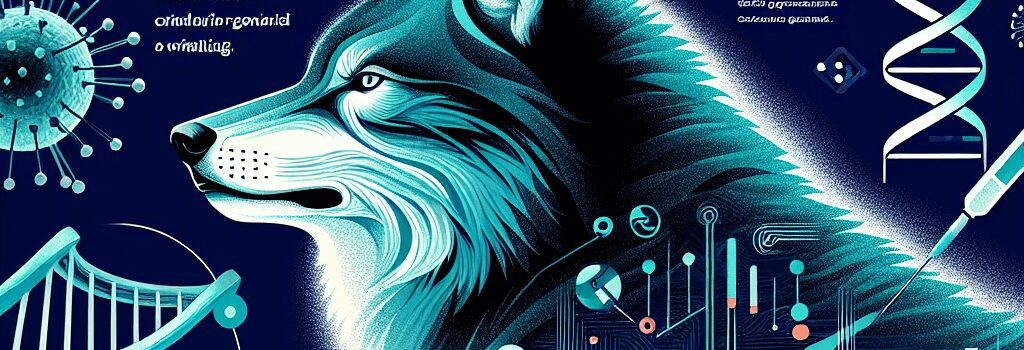Colossal’s Bold Move: Reimagining the Dire Wolf with Precision Genomic Editing

On Monday, biotech innovator Colossal unveiled what it heralds as its first successful foray into de-extinction, announcing the return of the dire wolf. While some of the fanfare paints an image of prehistoric savagery brought back from extinction, the technical achievements underpinning this project are rooted firmly in modern genomic editing.
The Science Behind the Revival
The new animals are derived from grey wolves modified with a series of precise genetic edits designed to mimic key dire wolf traits. Researchers compared the genomes of dire wolves recovered from Late Pleistocene remains with those of grey wolves, identifying a divergence that dates back over 2.5 million years. This gap, more than twice the evolutionary split between brown and polar bears, provided the blueprint for the genetic modifications.
Colossal’s internal research indicated that differences in 14 genomic regions—amounting to 20 total edits—were required to recapitulate the dire wolf phenotype. In the published details, 15 genomic variants have been engineered into grey wolves. Although the full breakdown remains undisclosed, it is evident that the approach was not to completely overhaul the grey wolf genome but to carefully introduce select alleles known to impact size and coat color.
Technical Deep Dive: Genomic Engineering and CRISPR Advancements
At the heart of this endeavor is the integration of CRISPR-based editing technology. By targeting specific loci within the genome, Colossal’s scientists were able to swap out variants that contribute to smaller size and darker coat colors for those found in dire wolves. Some edits involved introducing gene variants from naturally large grey wolf populations, ensuring that the animals would surpass average size metrics. Meanwhile, modifications to melanin regulation genes contributed to the lighter, almost white, coat that characterizes dire wolves.
Advanced bioinformatics pipelines and machine learning algorithms aided in predicting the impact of each edit, minimizing potential off-target effects. Such integration of AI has streamlined the design and validation process, making it possible to refine genome edits that would otherwise require generations of selective breeding to achieve.
Ecological and Evolutionary Considerations
Despite the dramatic announcement, the recreated dire wolves remain fundamentally grey wolves with engineered features. Their behavior, instincts, and ecological roles are expected to align with modern grey wolves, raising questions about the potential reintegration of such an animal into the wild. Historically, the dire wolf is thought to have specialized in hunting large megafauna that disappeared during the Late Pleistocene extinctions. Without a corresponding niche in today’s ecosystems, the reintroduced animals could face challenges in finding a functional role in nature.
Parallel efforts, such as those undertaken with woolly mammoths and woolly mice, highlight the complexities and ethical considerations surrounding de-extinction. Experts caution that even if the physical traits of an extinct species are resurrected, the ecological dynamics and behavioral aspects may not fully align with historical realities.
Expert Opinions and Industry Perspectives
Colossal’s approach has drawn both admiration and skepticism. Ben Lamm, a spokesperson for Colossal, emphasized that upcoming imaging and skeletal morphology assessments will help determine how closely these engineered animals mirror the extinct dire wolves anatomically. However, some independent experts stress that while the technical prowess is undeniable, the instinctual and behavioral characteristics remain a major question mark.
Leading genomic scientists highlight that using naturally existing variants from grey wolves to achieve these traits is a pragmatic choice. It leverages known genetic compatibility while bypassing some of the risks associated with introducing entirely novel genetic modifications. This technique is seen as a safe intermediary step toward more ambitious de-extinction projects.
Future Prospects and the Role of Biotechnology Innovation
The dire wolf project represents a broader trend in biotechnology where precision gene editing is not just a tool for therapeutic applications but a platform for biological reinvention. The integration of high-throughput sequencing, AI-driven genomics, and CRISPR editing is paving the way for innovations that could eventually transform conservation strategies.
Looking ahead, Colossal aims to expand its portfolio of de-extinction efforts, potentially addressing species that may have ecological roles in rewilding initiatives. Such projects might benefit from advanced computational modeling to simulate environmental interactions, ensuring that reintroduced species can adapt to current ecosystems.
Implications for Innovation and Beyond
Beyond the scientific and ecological implications, this initiative is a remarkable case study in startup innovation within the biotech space. Colossal’s project is being closely watched by investors and environmental groups alike, representing the fusion of genetic engineering with startup agility. The project raises important debates on ethics, ecological balance, and the feasibility of resurrecting extinct species while ensuring biosafety standards.
In conclusion, while the recreated dire wolves may not be a perfect match for their prehistoric predecessors, the technological achievements behind this project signify a leap forward in our ability to manipulate and understand genetic codes. The future of de-extinction and ecological restoration may well depend on these groundbreaking innovations.
Source: Ars Technica